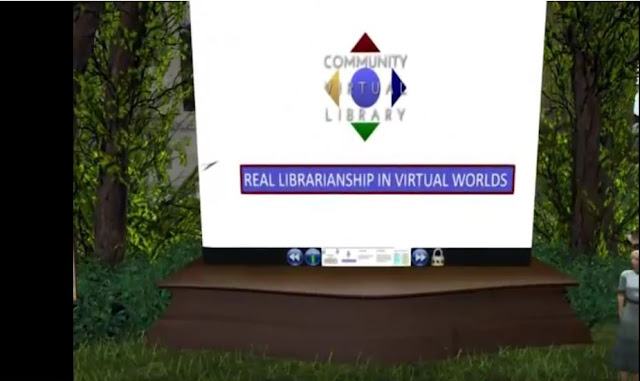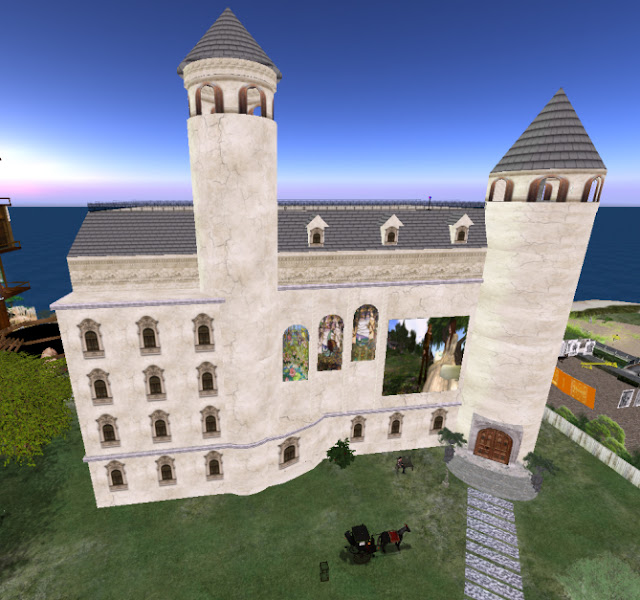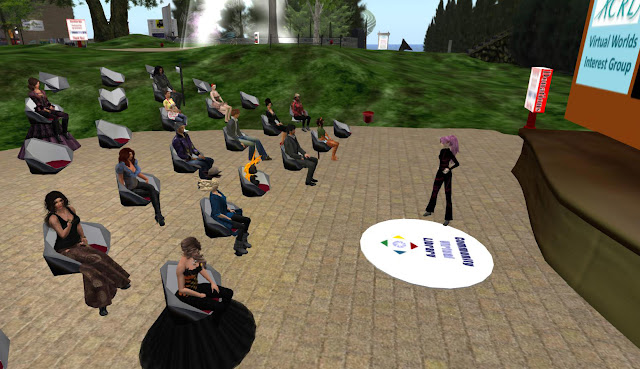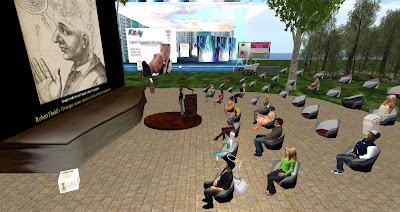ACRL-VWIG & ALA Virtual Communities in Libraries Program
January 21, 2018 12PM SLT
at the Community Virtual Library in World in Second Life
on Cookie Island 100/107/21
January 21, 2018 12PM SLT
at the Community Virtual Library in World in Second Life
on Cookie Island 100/107/21
"Tour of the New Community Virtual Library"
presented by: Valibrarian Gregg aka Valerie Hill
At the January 2018 ACRL-VWIG monthly program, Valibrarian used both voice and text chat to take the members on a tour of the new Community Virtual Library facility and grounds
located on Cookie Island.
The library is just one of the many educational features found on Cookie Island. It is a real working environment. The main library serves as both an information resource and a networking hub with it's Virtual Worlds Database-Second Life and beyond.
Head Reference Librarian SueMoon Magic and other librarian volunteers are available as noted on the calendar at:
https://communityvirtuallibrary.wordpress.com/
These volunteers help to make this a real learning space.
The Virtual Worlds Database-Second Life and beyond developed for the CVL Library has been shared at the Virtual World Best Practices in Education Conference, SJSU's VCARA Conference and the OpenSimulator Conference. Work is currently being carried out to install and A.I. Bot to help answer health-related qeustions (with care taken to remind users to talk to their doctors!)
There is also a Networking Hub that take the form of treasure chests filled with contact information and information on scheduled events. There are numerous information resources that help connect the CVL library with other virtual world communities. Cookie Island is set up to facilitate group interactions and meetings. The space was designed to be extremely flexible in order to accommodate almost any type of program or display. Many groups already regularly use the resources there to present and discuss everything from cybersecurity to art projects. The existing Digital Citizenship Museum exhibit currently there will be incorporated into a new museum planned for later in 2018. Participants are invited and encouraged to propose small and pop-up exhibits. Currently there are four spaces available for art exhibitions and other kinds of displays at the CVL Library Land Exhibit Spaces. The idea is that the exhibits will change regularly. There will be a calendar to reserve a space to highlight specific virtual world events or topics. Other resources currently available include:
The Library Land Pier is a good place to visit with firends or to join one of the groups that meet regularly there.
At the Library Land Pier, you can visit with friends or join one of the many groups that meet there. There is a trivia night gaming group. You can also experience tai chi on the beach.
There is a comfortable campfire area for book discussions. Science Fiction seems to work very well for discussions in Second Life and January's selection is Rainbow's End by Vernor Vinge. The book club meets on the 4th Friday of the month at 6pm SLT.
An art study group also meets on Mondays at 6pm SLT on Sunset Beach. This group has been meeting for about a year. Sunset Beach is a good place to put up experimental works. There will be a public calendar available to keep everyone posted on current and upcoming events.
Currently there is an exhibit on Venice in the 1600s by Brant Knutzen of the University of Hong Kong. There will be a live tour of this new simulation. It includes a recreation of a Renaissance library complete with the Gutenberg Press.
Another space on Cookie Island is the Virtual Poetry Garden. Last year Valibrarian helped sponsor a poetry contest on Twitter and this contest will take place again in April 2018.
Among the other amenities:
There is a theater where plays are produced and staged
There is also a group, Majestic Movies, active there which is working on a film project.
There's also a community pub, another good place for group meetings and celebrations.
Cookie Island and the facilities there have been designed to be a very comfortable, pleasing space for people to congregate, hold meetings and put up exhibits.
and here:
https://www.youtube.com/watch?v=0RxU_NURVo8
(My thanks to Ilene Pratt (Ilene Frank) for text and additonal photos and to Valibrarian Gregg (Valerie Hill) for additional photos for this post.)
presented by: Valibrarian Gregg aka Valerie Hill
located on Cookie Island.
 | |
| The new CVL Library building on Cookie Island |
 |
| The Reference Area |
https://communityvirtuallibrary.wordpress.com/
These volunteers help to make this a real learning space.
 |
| Real work stations link the library to internet resources. |
 | |
| Information kiosks. |
There is also a Networking Hub that take the form of treasure chests filled with contact information and information on scheduled events. There are numerous information resources that help connect the CVL library with other virtual world communities. Cookie Island is set up to facilitate group interactions and meetings. The space was designed to be extremely flexible in order to accommodate almost any type of program or display. Many groups already regularly use the resources there to present and discuss everything from cybersecurity to art projects. The existing Digital Citizenship Museum exhibit currently there will be incorporated into a new museum planned for later in 2018. Participants are invited and encouraged to propose small and pop-up exhibits. Currently there are four spaces available for art exhibitions and other kinds of displays at the CVL Library Land Exhibit Spaces. The idea is that the exhibits will change regularly. There will be a calendar to reserve a space to highlight specific virtual world events or topics. Other resources currently available include:
 | ||
| An outdoor auditorium for meetings. |
 |
| Library Land Pier, another area designed to facilitate small group interactions. |
 |
At the Library Land Pier, you can visit with friends or join one of the many groups that meet there. There is a trivia night gaming group. You can also experience tai chi on the beach.
 | ||||||
| Informal group space, Sunset Beach. |
An art study group also meets on Mondays at 6pm SLT on Sunset Beach. This group has been meeting for about a year. Sunset Beach is a good place to put up experimental works. There will be a public calendar available to keep everyone posted on current and upcoming events.
Currently there is an exhibit on Venice in the 1600s by Brant Knutzen of the University of Hong Kong. There will be a live tour of this new simulation. It includes a recreation of a Renaissance library complete with the Gutenberg Press.
 |
| Gutenberg printing press exhibit at the Venice exhibition. |
Among the other amenities:
There is a theater where plays are produced and staged
There is also a group, Majestic Movies, active there which is working on a film project.
There's also a community pub, another good place for group meetings and celebrations.
Cookie Island and the facilities there have been designed to be a very comfortable, pleasing space for people to congregate, hold meetings and put up exhibits.
The CVL will be working with other groups in Second Life like the Caledon
Library and there are plans to network with other virtual world grids as well. Second Life may be home base, but
librarians are encouraged to explore other grids. Writing groups, theatre groups, and others
are encouraged to work with the CVL and vice-versa.
Val pointed out that Second Life is not virtual reality and
that these two things seem to be very different experiences! Right now SL is a shared space. So far VR
doesn’t include social interaction. We
will have to see how virtual reality develops.
For Further info Val has set up several short machinima videos on Youtube which can be viewed here: (Press Control + left mouse click to open these)
and here:
https://www.youtube.com/watch?v=0RxU_NURVo8
(My thanks to Ilene Pratt (Ilene Frank) for text and additonal photos and to Valibrarian Gregg (Valerie Hill) for additional photos for this post.)
















































